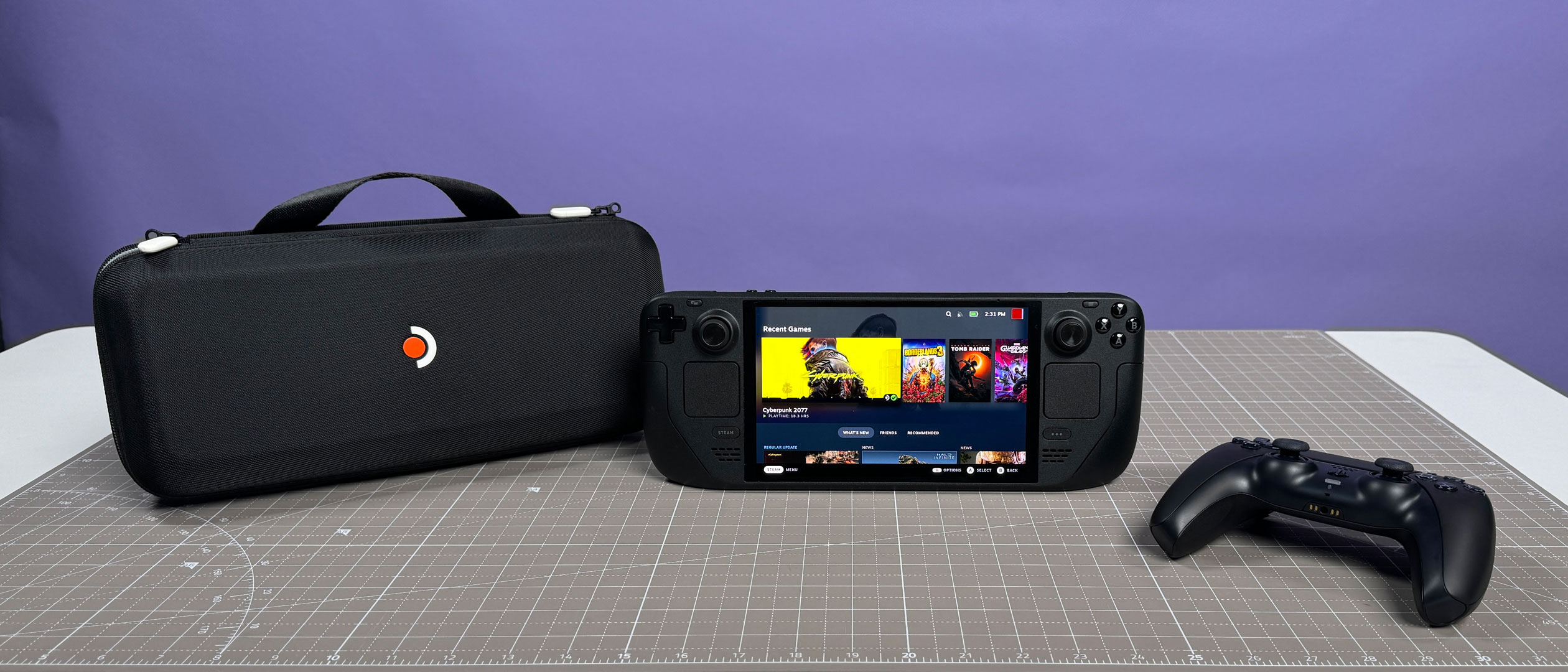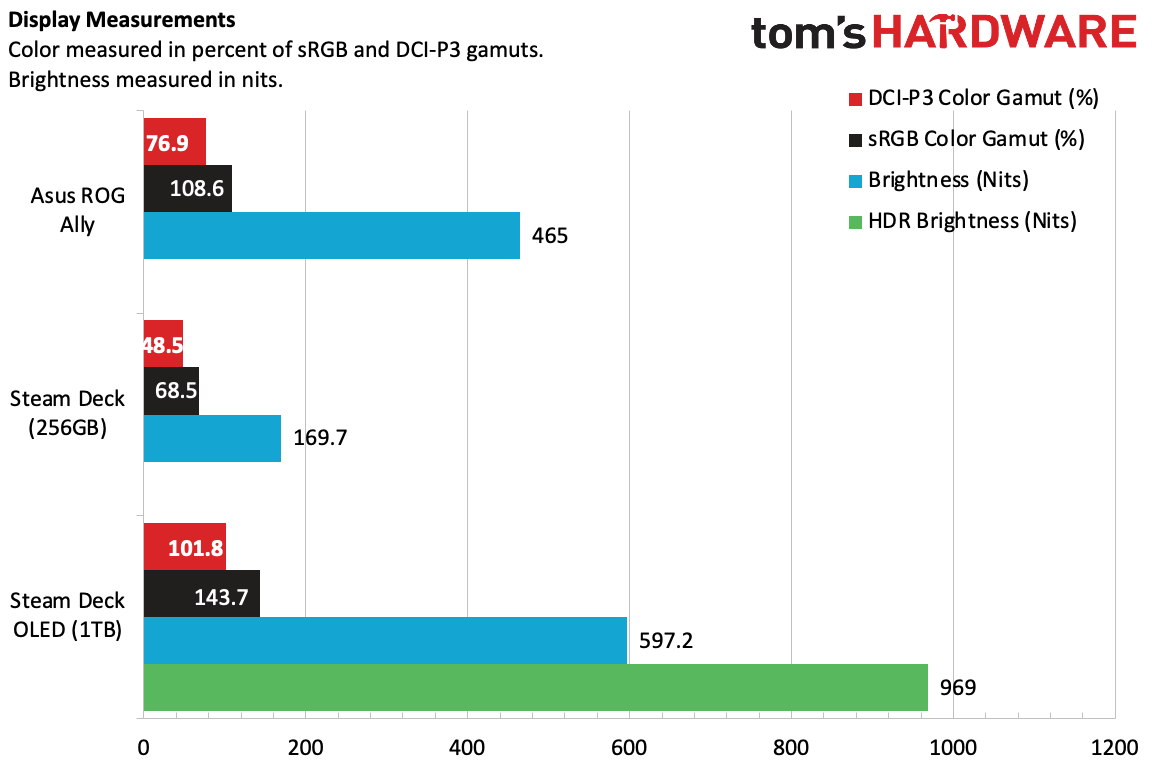Tom's Hardware Verdict
The Steam Deck OLED is a lighter, brighter version of Valve's handheld, with a larger battery and roomier storage options. But its performance is about the same, meaning it's likely only worth it for those who have waited to get a handheld gaming PC.
Pros
- +
Big, bright OLED display
- +
Larger battery
- +
Longer charging cable
- +
Wi-Fi 6E and Bluetooth 5.3
- +
1TB storage option
Cons
- -
HDR can be finicky
- -
Battery life is still not great for intense games
- -
Performance remains slightly behind AMD Z1 Extreme
Why you can trust Tom's Hardware
With the original Steam Deck, Valve took console-level simplicity and made it collide with PC-grade customization. Now, with the Steam Deck OLED ($549 to start, $649 as tested), Valve is taking another move from the console playbook: the mid-cycle refresh.
This isn't the Steam Deck 2, nor the Steam Deck Slim. Like Sony and Microsoft have before it, Valve is using a die-shrink for a more efficient chip, but isn't changing performance targets for the Steam Deck OLED. This makes for, in theory, more battery life, especially with a new, larger 50-watt hour battery. Of course, battery life is also tied deeply to the display, and here, Valve has gone bigger with a 7.4-inch OLED panel that gets quite bright, with support for HDR games.
There are also a slew of small changes, including a switch to Wi-Fi 6E, adjustments to repairability, grippier joysticks and better haptics, and storage options that go up to 1TB. But it still feels very much like its predecessor. This is definitely the best version of the Steam Deck out there, (and one of the best PC gaming handhelds) but I'm not sure you need to upgrade if you're happy with the one you have.
Design and Comfort of Steam Deck OLED
From afar, you might think the Steam Deck OLED is the same as the old Steam Deck. But once you pick it up, you can feel the difference.
The newer OLED Deck is just 30 grams lighter than the old Steam Deck (a 5% decrease), but it's noticeable in your hands. Don't get me wrong, at 11,73 x 4.6 x 1.97 inches (298 x 117 x 50 mm), the Steam Deck is still a large handheld device, making even the largest smartphones appear Lilliputian in scale. But I found the original surprisingly comfortable, and with less weight, the Steam Deck OLED is even more of a pleasure to hold. Note that the Steam Deck is 1 millimeter taller from back to front, thanks to redesigned thumb sticks (more on that below), but otherwise these are the same dimensions as the old model. For most, I don't think the thumb stick change will be a huge difference, but if you have smaller hands, you may notice it's a bit harder to press down L3 and R3.
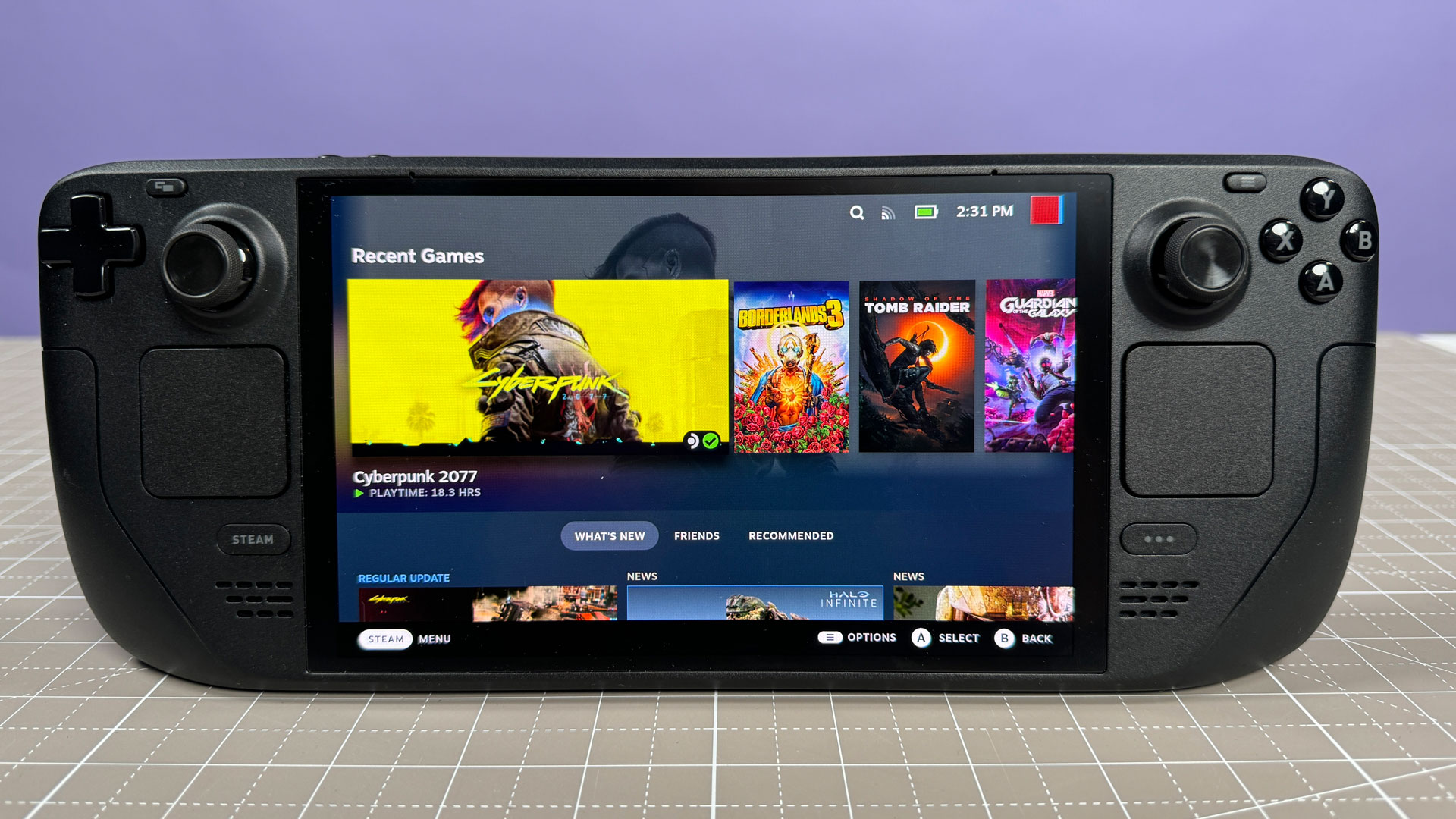
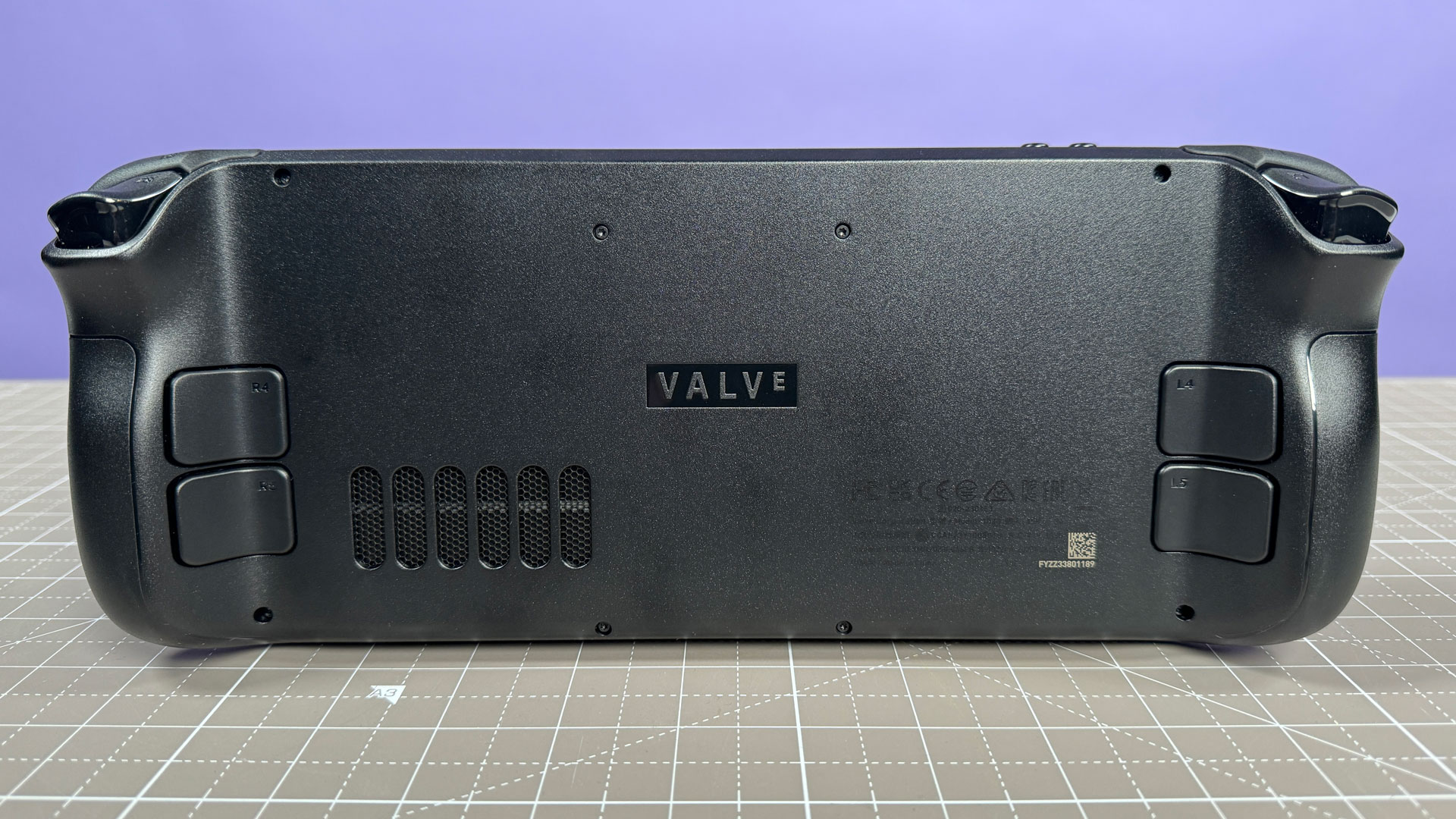
Physically, most of what you're seeing is the same. You have the same button layout, including A/B/X/Y buttons and a D-Pad beside, not below, the joysticks; dual trackpads; bumpers and triggers; and four programmable paddles on the rear. If you liked the last Steam Deck's layout, this one really isn't much different. I find it surprisingly comfortable.
That being said, while it's not different to the eye, there are changes. For instance, Valve has new thumbsticks with updated textures that I found better stuck to my thumbs. The company also boasts trackpads that it says should offer "improved fidelity and edge detection." I found that the haptics in the trackpads are greatly improved from the initial model, which I called "weak," especially when being used in on-screen keyboards.


Valve's other big change is that the screen has increased to a 7.4-inch diagonal; the LCD model has a 7-inch screen, so there are smaller bezels here.
Still, old issues, like flat Steam and "..." menu buttons that are basically inset with the chassis, have not changed. There's also only one USB Type-C port on top (near the new orange power button, volume button, and headphone jack), while competitors like the Asus ROG Ally and Lenovo’s Legion Go offer two of those ports. On the bottom, there's still the same UHS-I microSD card reader.
And while Valve has an official docking station for the Steam Deck, I still can't help but wish that this one had a kickstand for use with a controller.
The other changes are in the accessories that come with the Steam Deck OLED. Valve has moved to a longer charging cable. The adapter in the box now has a 2.5-meter cable, up from 1.5 meters. And with the 1TB model, you get a new, exclusive carrying case that seals with both a zipper and Velcro, has orange accents, and features an inner sleeve (also attached by Velcro) that can pull out if you need to save some room in your backpack
Get Tom's Hardware's best news and in-depth reviews, straight to your inbox.
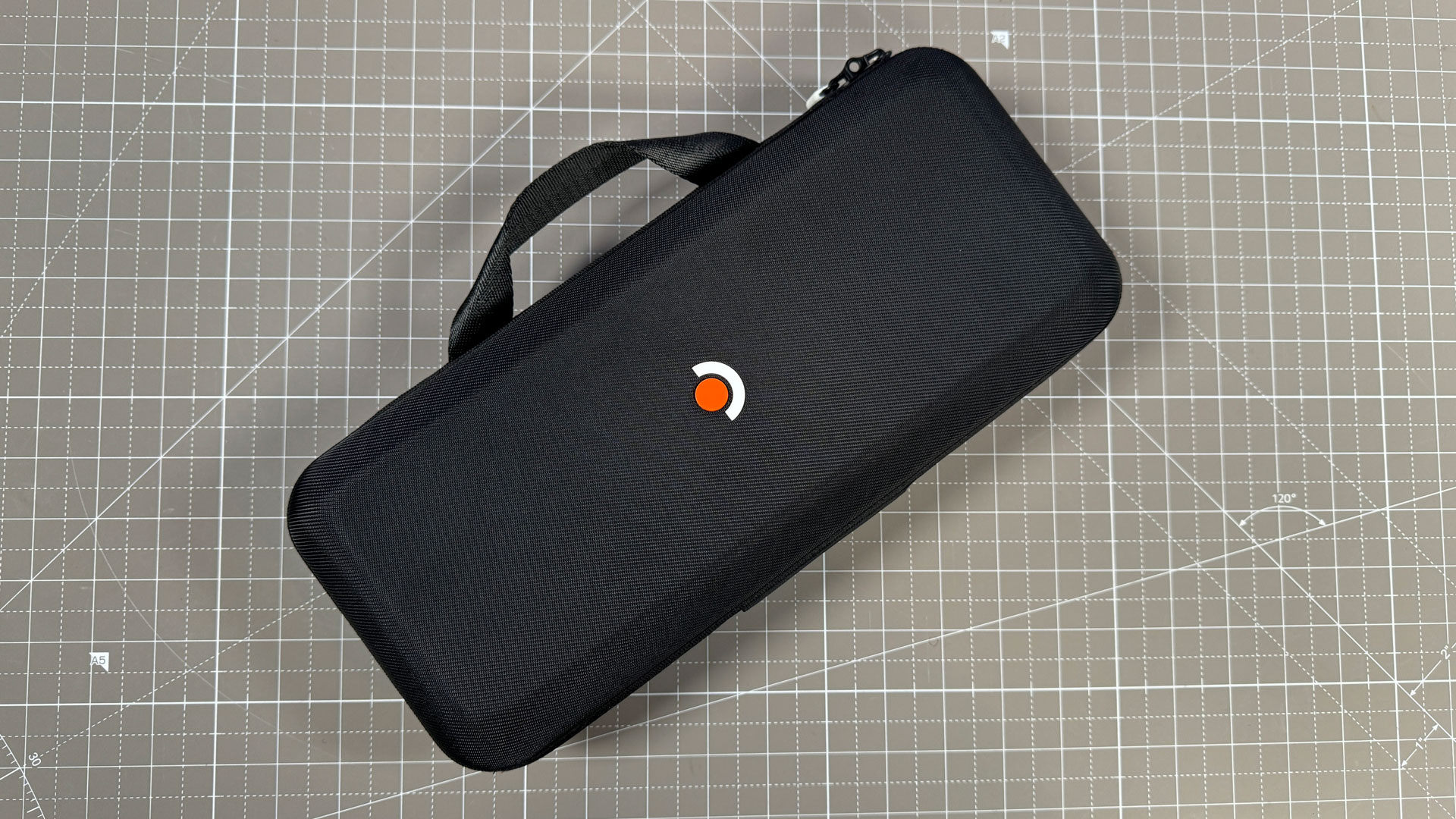


Steam Deck OLED Specifications and Components
Valve will tell you this isn't the Steam Deck 2. That's fair. In fact, in review materials, the company refers to the Deck OLED as the "Definitive first-generation Steam Deck," aiming for the same level of performance with no changes for developers for verification.
The biggest change to the internals is that the Zen 2 APU has seen a die-shrink. The Steam Deck OLED has a 6-nanometer version of the APU, with the same 4 cores, 8 threads, and 2.4 - 3.5 GHz speeds as the original, which was on a 7nm process. This should make the Steam Deck OLED's chip more efficient. There's also a larger fan, which shouldn't have to work as hard as the one in the original to keep the system cool, and therefore run more quietly. Additionally, Valve claims that faster RAM is good for power management and decreases latency, while resume time has increased by 30%.
There are also changes to wireless communications. The Steam Deck OLED has jumped to Wi-Fi 6E and Bluetooth 5.3, and the latter has a dedicated antenna which should make using Bluetooth accessories more reliable when also using Wi-Fi. You can also wake the system with a Bluetooth controller.
The Steam Deck OLED starts with a 512GB SSD and goes up to 1TB, so you shouldn't have to worry too much about swapping games out like the 256GB or 64GB original models.
| Header Cell - Column 0 | Steam Deck OLED | Steam Deck (LCD, Original Model) |
|---|---|---|
| CPU | 6nm, Custom Zen 2 "Van Gogh," 4 cores, 8 threads, 2.4 - 3.5 GHz | 7nm. Custom Zen 2 "Van Gogh," 4 cores, 8 threads, 2.4 - 3.5 GHz |
| GPU | 8 RDNA 2 CUs, 1.0 - 1.6 GHz | 8 RDNA 2 CUs, 1.0 - 1.6 GHz |
| Memory | 16 LPDDR5-6400 | 16GB LPDDR5 |
| Storage | Up to 1TB NVMe SSD | Up to 512GB m.2 NVMe SSD (PCIe Gen 3 x4) |
| Display | 7.4-inch touchscreen, 1280 x 800, HDR, OLED, 90 Hz, Anti-glare etched glass on 1TB model | 7-inch touchscreen, 1280 x 800 (16:10), 60 Hz, IPS, Anti-glare etched glass on 512GB model |
| Connectivity | Tri-band Wi-Fi 6E radio, Bluetooth 5.3 | Dual-band 802.11ac, Bluetooth 5.0 |
| Ports | USB 3 Gen 2 Type-C with DisplayPort, 3.5 mm headphone jack, microSD card reader (UHS-I) | USB Type-C with DisplayPort, 3.5 mm headphone jack, microSD card reader (UHS-I) |
| Battery | 50 WHr | 40 WHr |
| Power Adapter | 45W, 2.5-meter cable | 45 W, 1.5-meter cable |
| Operating System | SteamOS (Arch Linux, KDE Plasma on desktop) | SteamOS (Arch Linux, KDE Plasma on desktop) |
| Dimensions | 11,73 x 4.6 x 1.97 inches 298 x 117 x 50 mm | 11.73 x 4.6 x 1.93 inches / 298 x 117 x 49 mm |
| Weight | 1.41 pounds / 640 grams | 1.47 pounds / 669 grams |
| Price | $649 (as tested) | Up to $449 |
Display on Steam Deck OLED
The shining star of the Steam Deck OLED is, no surprise, the 7.4-inch OLED display with a 16:10 aspect ratio. Our review unit included etched anti-glare glass, and it really looks beautiful. While it maintains the same 1280 x 800 resolution as the original Steam Deck, the OLED panel is brighter, slightly larger, has deeper blacks, and goes up to a 90 Hz refresh rate.
Valve suggests the Steam Deck OLED's screen has a peak brightness of 1,000 nits (up from 400 nits on the original Steam Deck), although that's only available when you're running a game that supports HDR. Some games will automatically trigger HDR on the new Deck, while others require you to turn it on in settings. For SDR content, the Steam Deck OLED tops out at 600 nits, still a significant improvement over the original screen.
HDR looks great, especially in games with lots of color. Cyberpunk 2077's Night City has tons of neon lights that really pop, especially when it's evening in the game. But more importantly to me, the brighter screen in general just makes games look better than they do on the original Steam Deck, HDR or not.
You do need to fidget with the sliders a bit. For instance, if you have the brightness cranked up and then launch an HDR game, you may see some of the brighter colors blow out. In reviewer materials, Valve recommended keeping the brightness slider around 85% for HDR games, to allow the highlights to hit the 1,000-nit mark. Valve has a nifty little waveform viewer to show off the HDR tech specs, should you want to see how it's working out.
On our colorimeter, the Steam Deck OLED covered 101.8% of the DCI-P3 color gamut and 143.7% of the sRGB spectrum. In our standard tests, it reached 597.2 nits of brightness, while it went up to 969 nits in HDR with a tool Valve provided. HDR doesn't work off the desktop yet — you have to use it in game mode.
With the new 90 Hz refresh rate, Valve has made one significant change to the Performance menu in SteamOS. It has combined the refresh rate and fps limit into one bar: "game refresh rate," which Valve says will add more options, like "frame tripling a 30 FPS limited title on the 90Hz refresh rate screen."
For me, where the 90 Hz really shined was in pixel-style games, like Dead Cells, which don't need a ton of processing power. It's also a nice boon for esports. Counter-Strike 2 has its share of issues being played on the Steam Deck without heavy customization to the controls (or plugging in a keyboard and mouse), but at medium settings it ran consistently over 60 fps.
The 7.4-inch panel on the Steam Deck OLED is larger, diagonally, than the one on the Asus ROG Ally, which is 7 inches. However, they have different aspect ratios, with the Ally taking on a shorter 16:9 ratio, but with a higher resolution than the Steam Deck at 1920 x 1080. Lenovo’s Legion Go has a larger, higher-resolution 8.8-inch, 2560 x 1600 screen that’s also 16:10, but it’s IPS, not OLED, and the Legion Go is a significantly larger handheld.
Gaming and Graphics Performance of Steam Deck OLED
Valve claims that the new 6-nanometer APU on the Steam Deck OLED has the same performance targets as the Aerith APU from the original Steam Deck in games.
In our experience, that's pretty much the case. If you are a Steam Deck owner who was worried that the die shrink would make games run more smoothly than on your existing Deck, you can rest easy. In our tests, we found that benchmarks ran within a few frames of each other – generally within the margins of run-to-run variance.
If, on the other hand, you were hoping that a new Steam Deck would surpass the AMD Z1 Extreme in the ROG Ally, you may be disappointed, though the Z1 gains are still pretty small. The Ally only sees significant gains when it's plugged in and uses Windows 11's Turbo Mode. Since these systems are portable, I really feel that unplugged performance should be the benchmark. Valve's handhelds perform the same whether on battery or plugged in, which means you get the same experience everywhere.
| Header Cell - Column 0 | Steam Deck OLED (1280 x 800) | Steam Deck (1280 x 800) | Asus ROG Ally (Unplugged, 720p) |
|---|---|---|---|
| Cyberpunk 2077 - Steam Deck Preset | 34.89 fps | 36.90 fps | 40.26 fps |
| Borderlands 3 - Medium | 44.85 fps | 47.20 fps | 49.12 fps |
| Shadow of the Tomb Raider - Medium | 43 fps | 45.33 fps | 47 fps |
Battery Life on Steam Deck OLED
Like any mobile system, the Steam Deck OLED's battery life will depend heavily on how you use it. That being said, a larger, 50 WHr battery doesn't hurt.
But that battery is powering a more capable, brighter, faster display. Even if the chip is more efficient, there are still trade-offs to make. Lowering brightness, potentially turning off HDR, and limiting frame rates will get you longer battery life. Valve claims a wide range of 3 - 12 hours of gameplay, depending on what you're playing. A 2D side-scroller like Dead Cells will likely go a lot longer than an intensive 3D game like Resident Evil Village or Cyberpunk 2077.
In fact, Cyberpunk was on the very low end of that, when played with HDR. The new display is a huge improvement for visuals, but using it at its brightest takes a toll. If you're on a flight, a train ride, or you just need more battery life, you'll want to stick to SDR and lower the brightness. It was no surprise to me that when I turned off HDR, I got a few minutes of gameplay added to my battery life estimate in the Performance Overlay.
For when you do re-charge, Valve now includes a longer power supply in the box, with a 2.5 meter cable (the original's was 1.5 meters). This is a welcome adjustment, but I would still like to see a detachable cable. Valve claims that improved battery chemistry means the deck charges faster, from 20% - 80% in 45 minutes. That seems like a massive range. When I tried charging the Steam Deck from a dead battery, after 45 minutes I turned it on to a 54% charge.
I do appreciate the RGB charging LED, which gives me a better idea of what my charging status is. It's nice to see a green light when it's done charging, whereas the old model only had orange and white status symbols.
Audio on Steam Deck OLED
Valve claims that it put in louder speakers in the Steam Deck OLED, with support for improved bass. Considering I was pleasantly surprised with the speakers in the original Steam Deck, improvements are gravy as far as I'm concerned.
In Cyberpunk 2077, the volume got quite loud, providing an even mix of talking bar patrons setting a scene, quickly devolving into gunfire, which was still somehow balanced with background music and lots of people screaming orders at each other. I'm not sure the bass was that much of an improvement, but the sound does seem like a very slight upgrade over the original. Neither beat out the best gaming headsets, of course.
When I was messing around on the KDE Plasma desktop, I installed Spotify from the Discover store. While I don't expect the Steam Deck to become anyone's go-to music device, the Postal Service's "Such Great Heights" sounded surprisingly decent for the size of the device, playing the song's buzzy low-end with equal power to the vocals and synthesizers. It doesn't fill the room the way a full laptop does, but it's pretty solid, considering. In fact, I didn't love music on the previous Steam Deck, so that may be where the new speakers benefit most.
Additionally, the 3.5 mm headphone jack can be used at the same time as the on-board microphone. A small change, but I'll take it.
Heat on Steam Deck OLED
The cooler on the Steam Deck OLED works just like the old one: It sucks cool air in from the back and exhausts it out the top. And just like the original Deck, this one manages to largely put the heat just away from where you hold the device, so it feels nice and cool even after a few hours of play.
In a heavy firefight early in Cyberpunk 2077, the Steam Deck reported the CPU and GPU floating just around 70 degrees Celsius. The hottest point on the back of the Steam Deck measured 33.3 Celsius (91.94 degrees Fahrenheit), in between where my hands lay, and exactly where one would expect the APU to be. The fan often reported speeds of up to 5,000 RPM.
There's a larger fan here, which, combined with the more efficient APU, should mean a cooler device overall. Don't get me wrong, you still hear the fan, though I didn't find it to be whiny like the one I had at launch.
Upgradeability of Steam Deck OLED
While the Steam Deck OLED may look largely the same from the outside, Valve has made changes that it suggests will greatly help repairability. (We'll have to see what happens when the guides go up at launch).
These changes include a switch to Torx screws with improved threads, which Valve claims helps reduce stripping screws. There are also fewer screws throughout the system. Machine screws on the rear corner are designed to be removed and reassembled consistently.
The company is also suggesting that "common repairs" will include fewer steps, though it hasn't detailed exactly which those are. We do know that the bumper switch is now located on the joystick board, and, more crucially, that repairing / replacing the display no longer requires taking the back off of the system.
Since the SD card reader is still in the same place, you'll probably want to make sure you remove any SD cards before opening the system, or else you might snap those in two.
SteamOS and KDE Plasma Desktop on Steam Deck OLED
If you're a Steam user on a gaming laptop or a PC, SteamOS will be familiar to you. Since the original Steam Deck launched, Valve has issued a ton of upgrades to SteamOS, including per-game performance profiles, easy undervolting, VRR and HDR, a lock screen and far more. Valve says that it has shipped over 300 updates in the last year and a half.
In fact, it's the operating system that in many ways defines Valve's advantages over Windows-based competitors. Everything can be controlled easily with the controls and touch screen. It feels designed for the device, while systems like the Asus ROG Ally require extra software on top of Windows 11 to use the controller in a useful fashion to get to a game.
Having that flow between the desktop and handheld client — the ease of use, the game controls, the features — makes SteamOS extremely user-friendly in a way that Windows 11 just isn't on a handheld gaming device.
The Steam Deck OLED uses SteamOS just like the LCD version, and Valve is promising that updates will be provided for both versions of the handheld. At the moment, Steam Deck verification hasn't changed. If a game is verified to run well on Steam Deck, it will be the same for both the LCD and OLED models.
For those who want a more classic desktop experience, that’s based on the KDE Plasma desktop. Valve has continued to release updates here as well, including better windowing, security enhancements, and more. I imagine that most people will stick to SteamOS, and I wouldn't blame them. But for those interested in emulation or just messing around with their computers, I appreciate that KDE Plasma is there.
Not all games run on Steam. Some Steam users with libraries that feature many other launchers may consider installing Windows 11 on Steam Deck, though some launchers also have unofficial versions that may work on Linux (like the open-source Heroic Games launcher that will run Epic Games and GOG). But I wish Valve would finally, officially, offer a way to dual-boot Windows and SteamOS on the Steam Deck – especially now that there’s more room on the new boot drives.
Configurations and Availability of Steam Deck OLED
We reviewed a 1TB Steam Deck OLED, priced at $649, with an anti-glare display and a case with a removable inner shell to slim it down. If you can deal with less storage (or plan to upgrade later, the OLED models will start at $549 without anti-glare.
A "Limited Edition" 1TB Steam Deck will cost $679, with the anti-glare screen, a translucent plastic shell for that '90s aesthetic, and more orange accents. It will also have a case with a special design on the inside, so at least you'll know you got the special one. This version will be sold in the US and Canada only.
The existing Steam Deck with an LCD screen will see some price drops. The 64GB version with eMMC storage will drop to $349, while the 256GB model will fall from $529 to the old base $399 spot. The 512GB model also takes a nice dive from $649 to $449, making these far more competitive with Windows-based hardware like the Asus ROG Ally and Lenovo Legion Go.
Bottom Line
If you were on the fence about getting the original Steam Deck, now is a better time than ever. The LCD models have become even more affordable, while the new OLED model adds plenty of quality-of-life enhancements for those willing to shell out for the top-end configurations.
The OLED panel, though it can chew through battery, is lovely in comparison with the original. A more efficient chip (with effectively the same performance as the old one), along with updates to Wi-Fi 6E, grippier thumbsticks, better haptics, and larger storage options make for what's easily the best version of the Steam Deck.
If you already have an older one, especially with 512GB, it's hard to recommend replacing that with this new one, especially if you're happy with it. The key thing — performance — hasn't changed. But if you're playing light games that will last longer with the newer battery or want a more vivid screen, I can see the appeal.
In many ways, the Steam Deck is catching up to the Asus ROG Ally, which has a brighter screen and lighter weight. If you want Windows 11 preinstalled, that may be the way to go, though you'll want to keep the charger with you. And the ROG Ally, at $699, is still more expensive than the 1TB Steam Deck, with less storage but a higher-resolution display. (The Ally, however, has gone on sale recently for less, so we'll see if that's something that eventually sticks.)
But if you don't yet have a Steam Deck, play most of your PC games on Steam, and want the best software experience, Valve has polished its initial hardware vision quite well. I doubt we'll see a version with more ports, more power, or other nitpick fixes until an inevitable Steam Deck successor.

Andrew E. Freedman is a senior editor at Tom's Hardware focusing on laptops, desktops and gaming. He also keeps up with the latest news. A lover of all things gaming and tech, his previous work has shown up in Tom's Guide, Laptop Mag, Kotaku, PCMag and Complex, among others. Follow him on Threads @FreedmanAE and BlueSky @andrewfreedman.net. You can send him tips on Signal: andrewfreedman.01
-
Giroro I still regret that I ever bought a Steam Deck. They're so giant and unwieldy, but they make it look small way smaller than it is in the marketing.Reply
If they had at least used all that extra space for a bigger and less-crap screen ... that would at least be one less thing to point and laugh at. I think I still wouldn't like it though. It would still feel like gaming on an etch-a-sketch, and still look way too silly to use in public. -
Sluggotg With the die shrink, I would think you could Overclock and/or Undervolt to get more performance at the same power draw or longer battery life with the standard performance. Looks like a good refresh of the platform.Reply -
thestryker I understand what Valve is doing with the Steam Deck, but I'm still a bit disappointed that there won't be one with a decent CPU for a long while.Reply
I think Qualcomm will likely charge way too much to land in a device like this, but a pure Zen 4c based custom SoC would probably be amazing.
I like my Ally a lot, but windows is as much a disadvantage as advantage. Valve's hardware control is fantastic on the Deck and much simpler to set than any Windows based handheld. -
P1nky There's no way the original Deck had just 167 nits screen! Check your numbers. It should be at least 400, but most people measured it above 500 nits.Reply -
P1nky You're the only publication where OLED scored lower FPS than the original. It should be the opposite. Check your numbers.Reply -
digitalgriffin With no real GCN (Polaris&vega apus) support from AMD anymore, steam really needs to get some 8000 chips in there ASAPReply -
LabRat 891 Reply
Unrelated. Steam Deck's been RDNA 2.0 since the start.digitalgriffin said:With no real GCN (Polaris&vega apus) support from AMD anymore, steam really needs to get some 8000 chips in there ASAP
All I want to know, is what parts are 100% swap'able w/ OG Steam Deck.
The OLED and larger fan is attractive. -
Order 66 This Steam Deck OLED came out of nowhere for me since I had remember that there wasn't supposed to be any new steam deck models.Reply -
digitalgriffin Reply
Well I learned something new.LabRat 891 said:Unrelated. Steam Deck's been RDNA 2.0 since the start.
All I want to know, is what parts are 100% swap'able w/ OG Steam Deck.
The OLED and larger fan is attractive. -
thestryker Reply
I'm not sure much will be, GamersNexus did a teardown and comparison video: 9jhRh11bTRAView: https://www.youtube.com/watch?v=9jhRh11bTRALabRat 891 said:All I want to know, is what parts are 100% swap'able w/ OG Steam Deck.
The OLED and larger fan is attractive.
